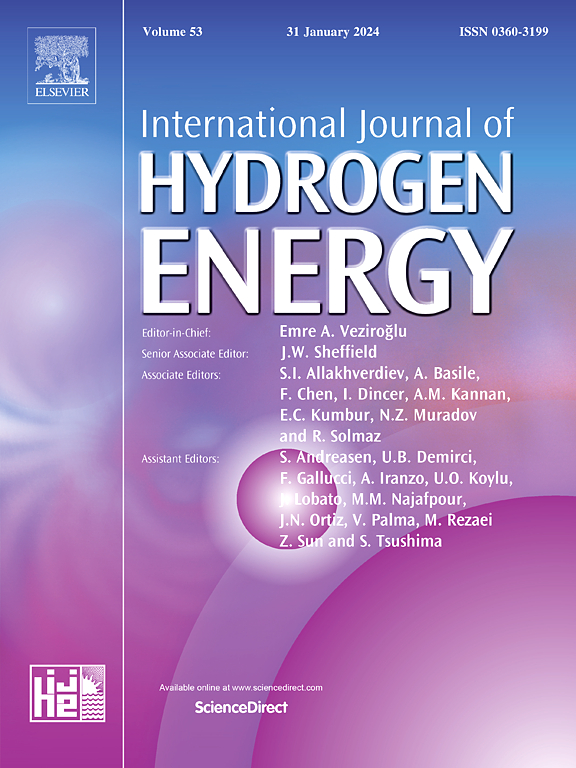Co-gasification of sewage sludge derived hydrochar and coal: Implications for syngas production and ash content
IF 8.3
2区 工程技术
Q1 CHEMISTRY, PHYSICAL
引用次数: 0
Abstract
The co-gasification of hydrothermally carbonized sewage sludge-derived hydrochar (HC) with SH coal under a CO2 atmosphere presents a promising route for sustainable energy generation and CO2 mitigation. This study systematically investigates the influence of HC-to-coal blending ratios and gasification temperatures on syngas composition, tar formation, and ash content. A blend of 25 wt % HC with 75 wt % coal at 950 °C was found to be optimal, achieving a 21.32 % ash and elevating the syngas lower heating value to 8.49 MJ/Nm3, thereby indicating enhanced gasification efficiency. The optimized blend was further evaluated at 800–950 °C to elucidate temperature-dependent behavior. Gas analysis revealed that CO2 remained the dominant component (>60 vol %), while H2 concentration increased from 40 % to 58 % with rising HC content due to intensified thermal cracking and organic matter depolymerization. Concurrently, CO concentration rose significantly from 16 % at 800 °C to 59 % at 950 °C, attributed to enhanced Boudouard and water–gas shift reactions facilitated by the CO2 environment. Tar analysis showed an increase in polycyclic aromatic hydrocarbons (PAHs) with higher HC ratios, highlighting a trade-off between syngas quality and tar burden. This work provides a comprehensive mechanistic insight into HC–coal co-gasification, underscoring the critical role of temperature and blending optimization in maximizing syngas yield while minimizing undesirable byproducts. The findings support co-gasification as a viable waste-to-energy pathway for sewage sludge valorization and reduced reliance on fossil fuels.

污水污泥衍生烃类和煤的共气化:对合成气生产和灰分含量的影响
在CO2气氛下,水热碳化污水污泥衍生烃类(HC)与SH煤共气化为可持续能源生产和二氧化碳减排提供了一条有前途的途径。本研究系统地考察了煤煤配比和气化温度对合成气组成、焦油形成和灰分含量的影响。在950°C下,25 wt % HC和75 wt %煤的混合物被发现是最佳的,达到21.32%的灰分,并将合成气的低热值提高到8.49 MJ/Nm3,从而表明提高了气化效率。优化后的共混物在800-950°C下进一步评估,以阐明温度依赖性行为。气体分析表明,CO2仍然是主要成分(60 vol %),而H2浓度随着HC含量的增加从40%增加到58%,这是由于热裂解和有机物解聚的加剧。同时,CO浓度从800°C时的16%显著上升到950°C时的59%,这是由于CO2环境促进了Boudouard反应和水气转换反应的增强。焦油分析显示,HC比例越高,多环芳烃(PAHs)含量越高,这凸显了合成气质量和焦油负担之间的权衡。这项工作为hc -煤共气化提供了全面的机制见解,强调了温度和混合优化在最大限度地提高合成气产量同时最大限度地减少不良副产品方面的关键作用。研究结果支持共气化作为污水污泥增值和减少对化石燃料依赖的可行的废物转化能源途径。
本文章由计算机程序翻译,如有差异,请以英文原文为准。
求助全文
约1分钟内获得全文
求助全文
来源期刊

International Journal of Hydrogen Energy
工程技术-环境科学
CiteScore
13.50
自引率
25.00%
发文量
3502
审稿时长
60 days
期刊介绍:
The objective of the International Journal of Hydrogen Energy is to facilitate the exchange of new ideas, technological advancements, and research findings in the field of Hydrogen Energy among scientists and engineers worldwide. This journal showcases original research, both analytical and experimental, covering various aspects of Hydrogen Energy. These include production, storage, transmission, utilization, enabling technologies, environmental impact, economic considerations, and global perspectives on hydrogen and its carriers such as NH3, CH4, alcohols, etc.
The utilization aspect encompasses various methods such as thermochemical (combustion), photochemical, electrochemical (fuel cells), and nuclear conversion of hydrogen, hydrogen isotopes, and hydrogen carriers into thermal, mechanical, and electrical energies. The applications of these energies can be found in transportation (including aerospace), industrial, commercial, and residential sectors.
 求助内容:
求助内容: 应助结果提醒方式:
应助结果提醒方式:


